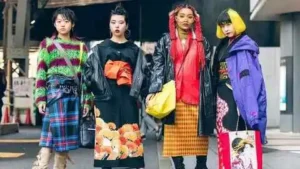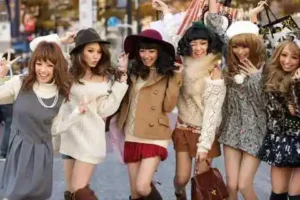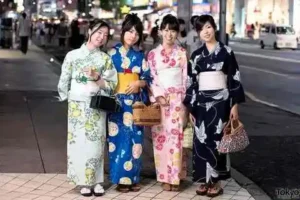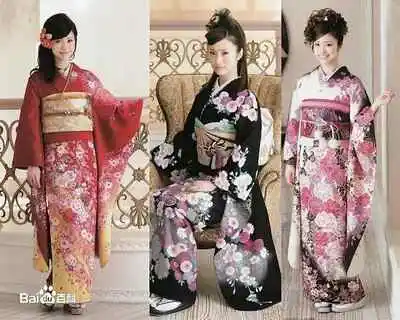Japan is known for its unique and ever-evolving fashion landscape, especially when it comes to women’s fashion. From traditional kimonos to streetwear, Japan’s fashion scene offers a wide range of styles, each with its own story and cultural significance. This article explores how women’s fashion in Japan blends heritage with modern-day trends, creating a vibrant and diverse fashion culture that continues to capture global attention.

A Look at Traditional Women’s Fashion in Japan
One cannot discuss women’s fashion in Japan without highlighting traditional attire like the kimono. The kimono, with its rich history and cultural symbolism, is the quintessential representation of Japanese elegance. Made of silk, with long sleeves and a wide belt (obi), the kimono is typically worn on special occasions such as weddings, tea ceremonies, and festivals.
- Kimono: A symbol of grace and beauty, often passed down through generations.
- Yukata: A more casual version of the kimono, typically made of cotton and worn in the summer.
- Obi: The wide sash that adds structure and style to the kimono or yukata.
Traditional clothing still holds a significant place in women’s fashion in Japan, especially during cultural festivals and ceremonies. However, the influence of Western fashion and modern styles has made its mark as well.
The Rise of Street Fashion in Japan
When you think of contemporary women’s fashion in Japan, the term “street fashion” often comes to mind. Japanese street fashion is unlike anything else in the world, known for its bold colors, eccentric designs, and mix of high and low fashion. Harajuku, Tokyo’s fashion district, is the birthplace of many street fashion trends that have gone global.
- Lolita fashion: Inspired by Victorian and Rococo styles, Lolita fashion is all about frilly dresses, bonnets, and elaborate accessories. It’s one of the most iconic fashion movements in Japan.
- Gyaru: This subculture focuses on over-the-top glamour, including bleached hair, heavy makeup, and trendy clothes.
- Decora: Known for its “more is more” philosophy, Decora fashion is all about layering colorful accessories, from hair clips to necklaces, creating a vibrant and playful look.
These street styles not only push the boundaries of fashion but also allow Japanese women to express their individuality in ways that traditional clothing may not.

Modern Influences on Women’s Fashion in Japan
The influence of Western fashion can be seen in the more minimalistic and functional styles worn by many Japanese women today. Brands like Uniqlo and Comme des Garçons have popularized clean lines, neutral tones, and high-quality fabrics in everyday wear. Japanese women’s fashion often combines these modern elements with traditional touches, creating a fusion that’s both elegant and avant-garde.
- Minimalism: Focusing on simplicity, quality, and comfort, minimalist fashion has gained traction in Japan.
- Mixing Tradition with Modernity: Many Japanese women blend elements of traditional fashion, like obi belts or kimono-inspired tops, with contemporary styles.
How Technology Shapes Women’s Fashion in Japan
Japan has always been at the forefront of technological innovation, and this extends to fashion as well. With advancements in wearable technology, fabrics that adapt to body temperature, and even fashion-forward robotics, the future of women’s fashion in Japan is increasingly intertwined with technology.
- Wearable Tech: From smartwatches to interactive garments that change colors, technology is playing an ever-growing role in Japanese fashion.
- Sustainable Fashion: With a focus on sustainability, eco-friendly fabrics and production methods are being embraced by Japanese designers, making women’s fashion in Japan both stylish and environmentally conscious.
The Global Influence of Japanese Women’s Fashion
Japanese women’s fashion has gone global, influencing designers, celebrities, and fashion enthusiasts around the world. The distinctiveness of Japanese street fashion, in particular, has found its way into global runways and mainstream fashion. Western designers often draw inspiration from Japan’s ability to mix the old with the new, the traditional with the avant-garde.
- Influence on Western Designers: Many Western fashion designers have been inspired by Japanese aesthetics, from the minimalist approach to fashion to the more outrageous Harajuku styles.
- Japanese Fashion Icons: Figures like Rei Kawakubo (founder of Comme des Garçons) and Yohji Yamamoto have become global fashion icons, solidifying Japan’s place in the world fashion stage.

Why Japanese Women’s Fashion Continues to Fascinate the World
What makes women’s fashion in Japan so captivating? It’s the freedom to experiment, the fearless blending of tradition with innovation, and the boldness to stand out. Whether it’s the elegance of a kimono or the avant-garde energy of Harajuku street fashion, Japanese women have always used fashion as a form of self-expression.
- Innovation and Tradition: The perfect marriage of innovation and tradition keeps Japanese women’s fashion fresh, exciting, and relevant.
- Self-Expression: Japanese women’s fashion is about more than just clothes; it’s a reflection of personality, culture, and even rebellion against societal norms.
FAQs About Women’s Fashion in Japan
1. What is the most traditional form of women’s fashion in Japan? The kimono is the most traditional and iconic form of women’s fashion in Japan, often worn during ceremonies and cultural events.
2. What is Harajuku fashion? Harajuku fashion refers to the eclectic and colorful street styles that originated in Tokyo’s Harajuku district. It includes various subcultures like Lolita, Decora, and Gyaru.
3. How has Western fashion influenced women’s fashion in Japan? Western fashion has influenced Japanese women’s fashion by introducing minimalist styles, functional wear, and modern trends, which have been blended with traditional Japanese fashion elements.
4. What are some modern trends in women’s fashion in Japan? Some modern trends include minimalist, functional wear influenced by Western styles, as well as sustainable and tech-integrated fashion.
5. How important is individualism in Japanese women’s fashion? Individualism plays a crucial role in Japanese women’s fashion, especially in street styles, where self-expression and creativity are highly valued.
Conclusion
Women’s fashion in Japan is a fascinating mix of the old and the new, the traditional and the avant-garde. From the timeless beauty of the kimono to the rebellious energy of Harajuku street fashion, Japanese women have made fashion a true art form. As global interest continues to grow, women’s fashion in Japan will undoubtedly continue to influence and inspire the world.
Read more: womenfashionwear.site

